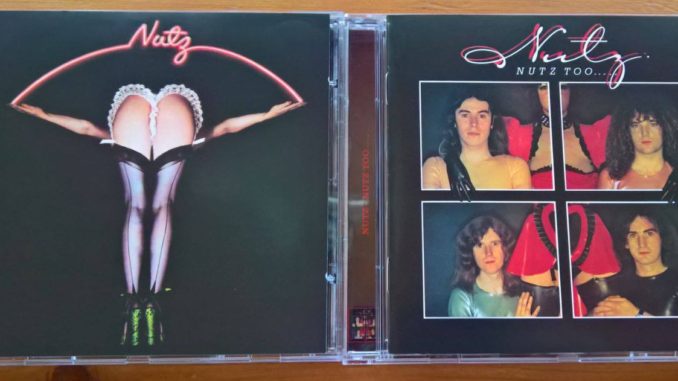
Nutz were part of the wave of guitar-based hard rock bands that emerged from Britain during the early 1970s. During that time, British bands became a major, worldwide force on the hard rock scene (Deep Purple, Black Sabbath, Uriah Heep, Led Zeppelin, etc.)
Several acts appeared in their wake hoping to make a similar impression. Most didn’t, but groups such as Strider, Stray, Bedlam, and Stretch were all popular on the UK gig circuit – as were Nutz, a group that had been building a strong live reputation since the late sixties.
Formed in their home city of Liverpool as Harpoon, this four-man unit built a strong regional following and managed to secure major management (linked to Peter Grant, Led Zeppelin’s infamous Svengali) and an enviable deal with the influential A&M label.
They recorded their first album with John Anthony (Queen, Roxy Music). The self-titled album Nutz appeared in 1974.
Thanks to a highly controversial sleeve they became one of the country’s most talked about acts for a short while, but the album also attracted strong reviews from the music press.
The album contains an impressive mixture of powerful hard rock, and more ambitious compositions such as the hard hitting Ain’t No Thanks To You (featuring superb slide guitar), As Far As the Eye Can See and one of my personal favourites with lovely all-band harmony vocals: Light of Day. It also showcases some exceptional individual performances, particularly from vocalist Dave Lloyd and guitarist Mick Devonport.
Capitalising on the positive buzz and strong reviews, the band instigated an intense gigging schedule, which included opening for Queen on their 1974 tour. It was a solid exercise in laying the ground work for the future.
With a positive reputation established, the group set about recording their follow-up album the following year in London’s Trident studios. Once again they utilised John Anthony as producer, who had so successfully guided their debut. It wise a wise move as the resulting album Nutz Too showed distinct maturity and a great gift for constructive arrangements. It also continued to showcase the musical talents of the band.
Issued in 1975 and, once again, housed in a somewhat risqué cover, Nutz Too housed a brace of intelligent and well-constructed tracks that veer from on-point mid-seventies hard rock such as Take It From Me, Cool Me Down and the upbeat Sinner, to more introspective fair like Dear Diary and The Love You Lost.
The record was solid, and got them enough attention that they were invited to appear on the BBC’s Old Grey Whistle Test TV program. As cool as the TV experience was for the band, that was to be their pinnacle.
While they did get on TV this once, they just did not manage to get any kind of airplay on Radio 1. This was vital in those days if you wanted to score any kind of hit or get the needed exposure to boost your following.
They tried to compensate for this by touring consistently, but it did not help that after the Queen gigs, almost all of it was at club level. Only in Liverpool, their home town, were they able to play theatres.
One can certainly not say that they had a lack of success, but the feeling of not being able to progress past a certain level would eventually wear down the band. They released another studio album (Hard Nutz, 1976) and a live album (Nutz Live Cutz, 1977) but none fared particularly well. They got support slots with Black Sabbath and Budgie, and even a Friday night slot at the 1976 Reading Festival, but it simply did not further their cause.
The band would likely have ended by 1979, and for practical purposes they really did. Their career got an interesting postscript when their song Bootliggers was surprisingly chosen for inclusion on 1980’s Metal for Muthas. This is a now legendary compilation of emerging New Wave of British Heavy Metal talent, like Iron Maiden, Praying Mantis, and Samson.
Nutz decided to cash in on this and focus on the younger generation of fans by reinventing themselves as the NWOBHM-band Rage (not to be confused with the German power metal trio that appeared a few years later). They really were a barely disguised new version of Nutz. minus their keyboard player and with an additional guitarist. As Rage they went on to record three more albums before finally breaking up in 1984.
As far as Nutz, their two first albums remain highlights from that mid-70s era. They are very much of their time musically, but that is really the main draw and exactly why they still remain so alluring to fans of hard 1970s rock’n’roll.

Facebook Comments